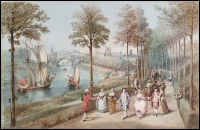History of New Walk

New Walk is a tree-lined avenue created in the 1730's, during the reign of George II, following the River Ouse from the Tower Gardens downstream for approximately one mile. With the opening of the Millennium Bridge in 2001, it is now possible to cross the river and return to the city on the opposite bank, passing Rowntree Park on the way. At a leisurely pace, the walk will take around one hour to complete.
Originally set out as a formal space for the fashion conscious to stroll and socialise, New Walk also offered a welcome escape from the city. Even though the character of the walk is not so genteel today, there is still a sense of occasion as you leave the noise and bustle of the city to embark upon one of England's first riverside walks.
New Walk initially stretched to Skeldergate Bridge to the junction where the river Foss joins the Ouse. When it opened to the public, visitors and residents alike were given a unique opportunity to walk along the banks of the River Ouse, shaded by parallel rows of elm trees. Although the first trees to be planted were elms, other varieties were later interspersed among them. The trees would have reached full maturity by 1889 and are the very large trees we can see today. The younger trees are mostly replacements for the elms, which had to be cut down in 1980 after an outbreak of Dutch Elm Disease.
To us this type of urban walk may not seem so remarkable, but its creation was an important part of the attempts made by the eighteenth century City Corporation to raise York's status to that of a leading Georgian social centre. The city sought to provide entertainment for the gentry and burgeoning middle classes of the period to enjoy. New Walk was just one of the developments aimed at attracting such people to York. Other important contemporary landmarks included the Assembly Rooms, the Mansion House and the Racecourse. New Walk proved to be extremely popular, being one of only a few such walks in the country, and was soon extended further out of the city. To allow for the continuation of the walk the original Blue Bridge was built in 1738.
In keeping with the preference of the time for order and formality, hedges were planted to separate the gentrified walk from the surrounding natural and wilder landscape. The ground was levelled and further rows of elms were planted, providing a shaded leafy avenue with dappled, light filtering through in the summertime.
During the 1830's the first houses were built alongside the walk. From this time onwards, New Walk required a new identity as a safe alternative to the main road into the city. Today York's residents use New Walk to travel either on foot or by bicycle from the suburbs to the centre of town. Meanwhile visitors can still enjoy a chance to escape the city and walk along the banks of the river. The Walk's main features are still clearly visible, including the iron gates and railings just over the Blue Bridge marking the beginning of the second part of the Walk, dating from 1929 and Pikeing Well designed by John Carr in 1752.
Since the erection of the Millennium Bridge the volume of walkers has increased dramatically. The Millennium Bridge allows a circular route to be adopted, returning to the opposite bank via Rowntree Park. This unique Edwardian park was established by York's celebrated chocolate maker, Joseph Rowntree. New seating offers visitors a chance to rest and view the river and information plaques tell the fascinating story of this historical walk.